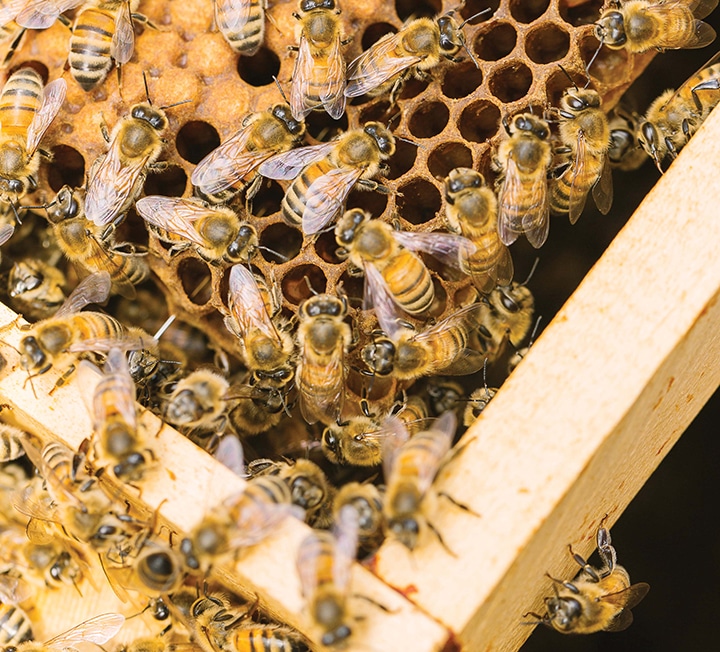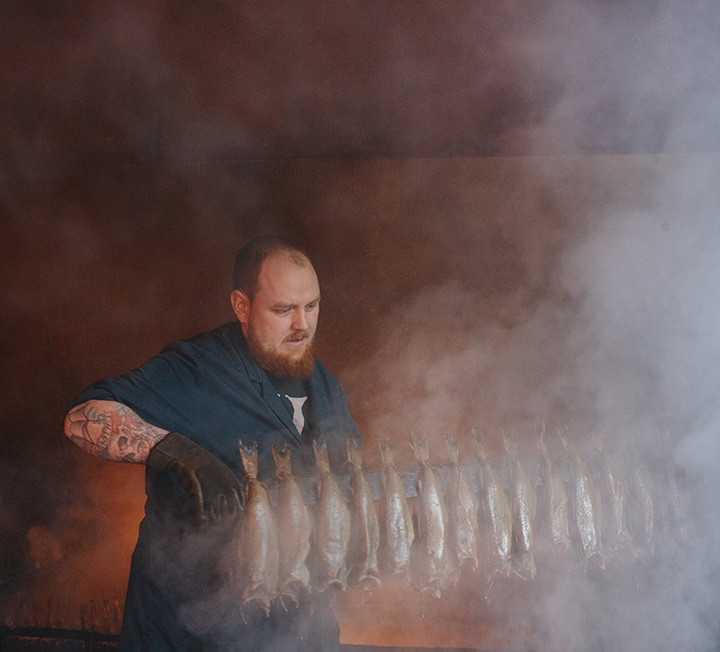Hot flush
First flush Darjeeling is among the most highly regarded of all the world’s teas. Clare Finney pays a visit to the Gopaldhara tea lodge in the lush hills of West Bengal to watch it being harvested and discover what it is that makes it so sought after
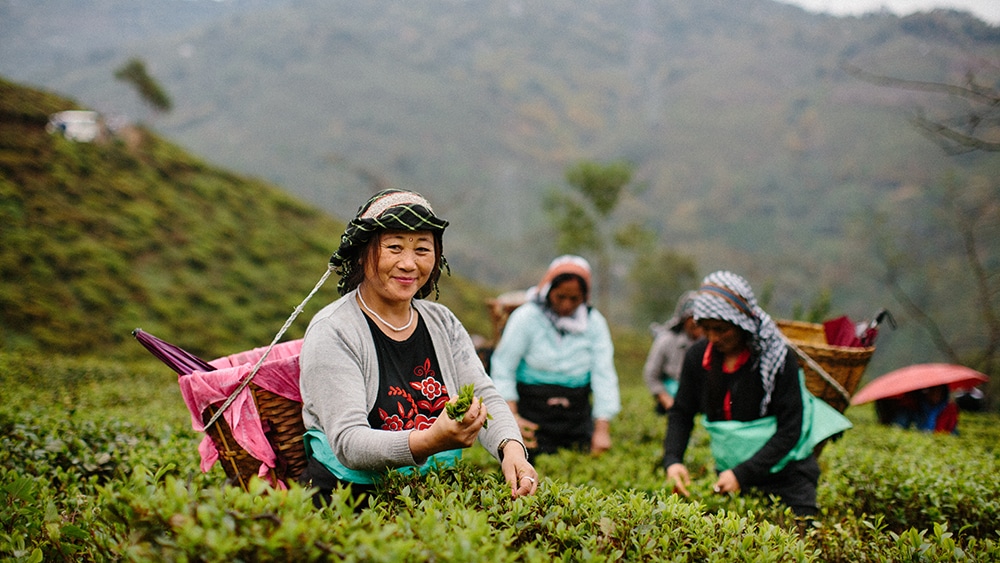

“THE MONARCH OF DARJEELING TEA IS FIRST FLUSH, HARVESTED WHEN THE FIELDS AWAKEN FROM THEIR WINTER HIBERNATION”
Images: Tom Bradley
It’s the heat that hits first: the thick, claggy heat, then the honking and fumes of the swarm of vehicles clamouring around the airport. Scanning the sea of faces as I step outside, I feel the sensory assault everyone had told me I’d experience upon first arriving in India – together with a tremor of misgiving as I take in the yellow fog and crammed, dusty buildings. My concerns are interrupted by a shout – “Clare! Over here!” – and the sight of a familiar face beaming atop a wholly unfamiliar outfit. In Borough Market, at his Tea2You stall, Ratan Mondal is one of the more smartly dressed traders, never seen without a suit jacket and chinos, but here in West Bengal his dapper ensemble has been replaced by shorts, a floppy sun hat and a safari-style shirt.
He waves a wooden walking stick and, once I’ve pushed my way through the crowds, takes my hand. “Welcome to Bagdogra! Are you hungry? Because it’s a three-hour journey up into the mountains.” I sigh with relief – not because I relish the prospect of a three-hour drive along dirt roads, but because for a confused and jetlagged moment I’d thought this pollution-choked city was the site of the tea plantation from which Ratan sources his Darjeeling tea. A hair-raising drive later and, while my nerves are on edge, my misgivings have dissipated entirely. Drawing up at Gopaldhara tea lodge, we appear to be suspended amid skeins of cool mist and waves of lush foliage, rolling down into the Mirik valley. There is no sound beyond that of chickens, cockerels and dogs. There is – imagine! – no wifi. “This is Darjeeling,” says Ratan proudly, as we step out of the jeep.
Gopaldhara is enormous. The next morning, as the sun rises, I’m reminded of the scene in the Lion King when Mufasa declares: “Everything the light touches is my kingdom.” Mahendra Kharti, the manager of Gopaldhara for the last 20 years, employs about 600 people, across over 320 hectares. His is one of 87 tea estates in the Darjeeling hills that have been accorded the right by Tea Board India to label their produce Darjeeling tea. In total, these estates cover more than 17,500 hectares of land, produce around nine million kilos of tea annually and employ around half the population of the Darjeeling district. It’s big business – and big bucks too, thanks to its prestige, popularity and the relative scarcity caused by its geographical restrictions.

Of course, inscrutable merchants get around these rules by mixing cheaper teas in with Darjeeling and passing it off as the real McCoy. Yet competition is fierce, even among respectable buyers like Ratan. “It is a tough job I’m doing, a very tough job – but I love the competition,” he grins. “I know the palate of my customers. I have knowledge of the tea.” The art of trading tea, he says, is in balancing numbers. “The better the quality of the tea, the less of it is produced.” That’s why the first flush of Darjeeling is so sought after: it’s produced in small quantities, over a very limited period. You might be King Charles – and indeed, His Royal Highness is one of Ratan’s customers – but when he’s sold out of first flush, that’s it. Everyone has to wait until next year. “You cannot dictate the crop. You can’t sell more than is grown.”
Which is where the fine balance comes into play. Over these few weeks in March and April, Ratan needs to buy enough first flush to keep his customers sated, but not so much he has stock left into the following year. Tea has a good shelf life, about 15 months, but those customers looking for first flush Darjeeling are not looking for leaves that are a year old. “Each year I have to work out how much I can sell. And I have to get the best, too,” he says.
Across the valley, the clouds are brewing and glowering menacingly. India has seven seasons to our three, and this – the beginning of summer – features thunderstorms and lightening most mornings. “You cannot predict the weather,” says Kharti, looking at the sky with surprising calm, given its implications for today’s harvest. Already the first pickers, deceived by the early morning sunshine, have started retreating.
The heavens open. Thunder rolls. The feeble power supply in the lodge splutters out completely. It’s dramatic, but also disastrous for both our photographer Tom and for Kharti, who now stands to lose not just a morning’s picking, but a morning’s processing too. His factory sits at the bottom of the valley, just out of sight from where we’re staying. We’d planned to walk down but until the rain eases, he says, no one can go anywhere. The paths are too steep and slippery to pass by foot or by vehicle. There is nothing to do but wait and – one silver lining – drink tea.
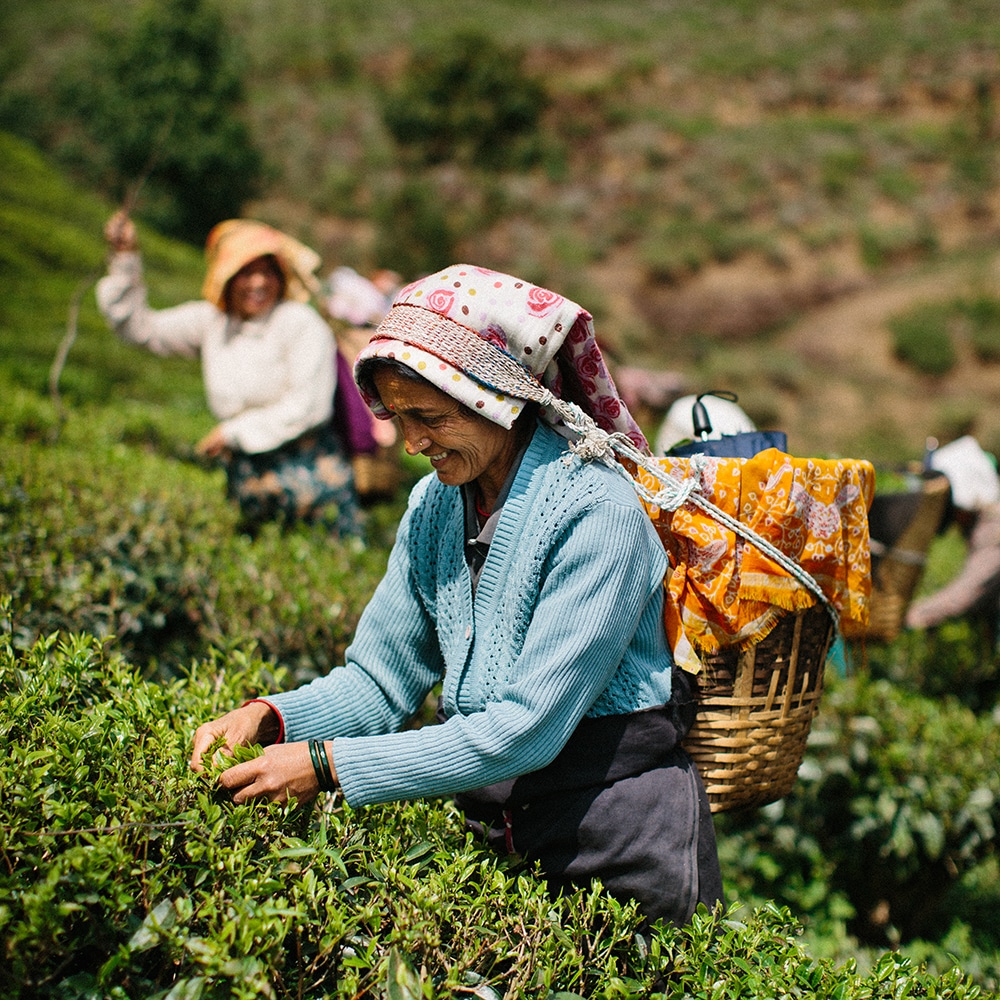
We wait with anticipation, the thunder grumbling around us, until Kharti’s housekeeper Didi emerges with a glass teapot of golden liquid. “Is this first flush Darjeeling?” we ask in hushed whispers. “Yes,” says Ratan, giggling delightedly, “but it is not very good.” I smile, wondering if his joke is lost on me – but he is in fact being entirely honest. “The best tea is exported. We don’t keep good tea in India, because abroad it has so much more value. Indian customers who want first flush? They buy it from England.” He laughs again, delightedly. “They buy it from me.”
Thus ends the first of many lessons about tea hierarchy – a hierarchy that makes the British class system look straightforward. Though all tea is the same species of plant, Camellia sinuses, it varies endlessly according to terroir, climate and how it is processed. The monarch of Darjeeling tea is first flush, harvested when the fields awaken from their winter hibernation, and is referred to as FTGFOP, ‘fine tippy golden flowery orange pekoe’ – or “far too good for ordinary people” as those in the trade jokingly have it. ‘Tippy’ refers to the tips, or buds, on the bushes; ‘golden’ to the tinge of leaves picked early in the harvest; and ‘orange pekoe’ to the fact it is whole leaf. “Orange pekoe is not a type of tea,” stresses Ratan. In the cup, FTGFOP commands delicate, fragrant flavours with astringency and beautiful sweetness. Golden flowery orange pekoe (GFOP), meanwhile, could be described as the landed gentry of Darjeeling: a whole leaf tea harvested in first flush, but with a slightly lower proportion of golden tips.
From there the tea descends in ‘class’ according to where it is harvested and how it’s processed. While most Darjeeling tea is produced using the orthodox method, meaning the leaves are kept whole and there is limited mechanical interference, outside of Darjeeling the most commonly found type of tea is produced by highly mechanical means, known as the cut, tear, curl (CTC) method. The leaves are passed through a series of teethed cylindrical rollers that crush, tear and curl the tea into small, hard bits, increasing the surface area and inducing that familiar bitter flavour. The result is piled into teabags, shipped, and served with sugar and milk.
“You don’t need milk with my tea,” boasts Ratan: indeed, to do so would be sacrilege, the equivalent of topping champagne up with lemonade or serving Parma ham with ketchup. “In the old days, the English used to lock up Darjeeling tea in their drawers. They saw it as gold dust,” he says nostalgically, “but English people don’t really know tea today.” Contrary to popular opinion, English breakfast is not a type of tea. It’s a blend of cheap black CTC teas from all over the world, picked in huge quantities. During a typical day on Gopaldhara tea garden, a picker will pick two to three kilos per person – perhaps just one, when picking the highest grade FTGFOP teas during a difficult season. “In Assam, where they are picking tea for CTC, an average picker will pick 25 to 30,” Kharti interjects somewhat disparagingly. In other words, they’ll pick indiscriminately, valuing quantity over quality, and with no thought as to the size of the leaf or its tips.
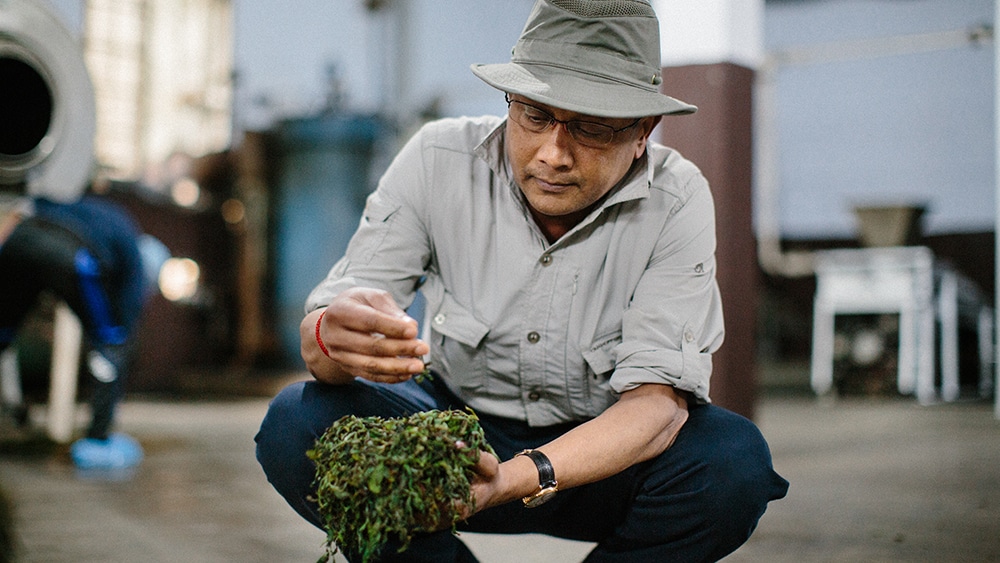
We are interrupted by the sound of birdsong. The weather seems to be turning, and within a few minutes the bell calling the pickers back to work is chiming insistently. A jeep pulls up and Kharti introduces us to his driver, “a very experienced man, who has been with me for eight years”. Within moments we are discovering why such experience matters. The Mizik Valley is steep: far steeper than the mist and green gardens suggested, and the dirt track running down to the factory is single file and edged on one side by a heart-stoppingly steep drop. What’s more, we’re reversing down it, at a pace that is far from cautious. I shut my eyes and try my best not to wonder how many accidents the driver has had or narrowly missed in the course of eight years.
“Gopaldhara Tea Estate” reads the welcome sign, in a colonial-style writing that reminds us that tea is not, after all, a traditional Indian crop, but one imposed by the British in the 19th century. Those colonial ties can be seen in the machines, half of which were made in Britain. The other, considerably shinier half are Taiwanese. On a sheet just outside the factory, the morning’s harvest is being laid out in what is now glistening sunshine. “It will sun-wither for two hours,” says Kharti, “depending on weather.” Inside, the factory is slowly warming up following the power cut, and for the next 20 minutes Kharti busies himself inspecting the various machines.
“The manager has arrived,” smiles Ratan as he watches his friend proudly. After nine years of trading, theirs is a relationship marked by respect and fairness. “He manages everything, from top to bottom. A tea manager is one of the most prestigious jobs you can have in this country – and Kharti is one of the best.” With 600 people under his care and numerous trading partnerships, Kharti speaks four languages – Nepalese, Hindi, Bengalese and English – and has a knowledge of tea Ratan says he can only aspire to. “I am his student,” he tells me modestly. “Don’t listen to him!” Kharti calls over. “Ratan is the master. He knows. He is the best.”
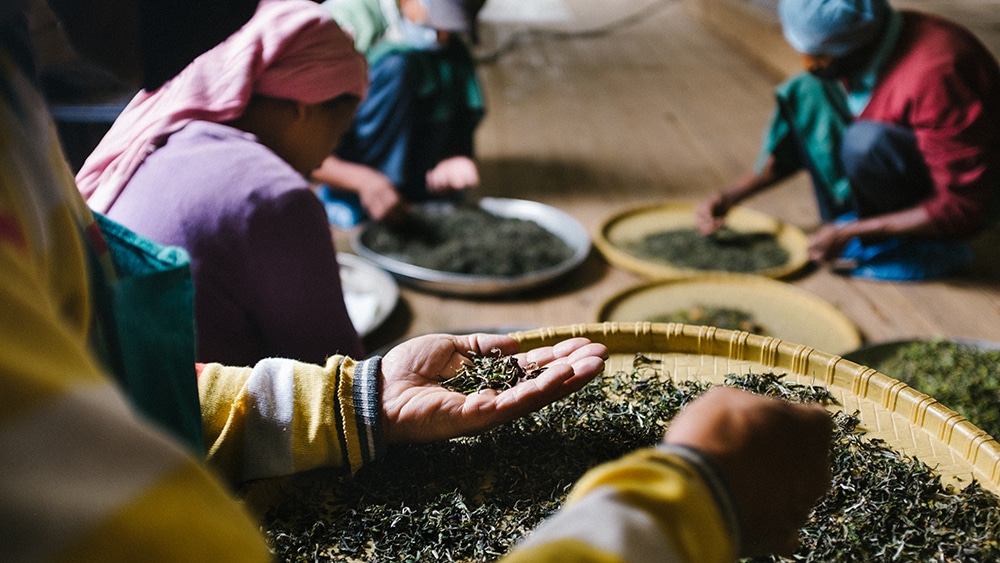
They agree to disagree and Ratan takes us upstairs, to long troughs where yesterday’s sun-withered harvest is being withered still further. This process involves blowing air through the leaves to dry them until they lose around 60 per cent of their moisture. Once supple, the now-dark green leaves will be rolled and oxidised – that is, fermented – and already there is a distinct, light but vegetal aroma rising off the withering leaves. Ratan can’t help but take a handful: “Smell that,” he says, proffering a fistful of leaves. Were Darjeeling a drug – and there are moments at which the long, curled tea leaves bear a striking resemblance to one – Ratan would probably need rehab. Mercifully for all concerned, that is where the resemblance finishes.
The depth of Ratan’s passion is echoed by everyone at Gopaldhara. It has to be. It’s a monotonous job, and there’s no step you can skip or fast forward. From picking to packaging, each stage demands care, attention and what Kharti believes is inherited skill. “You cannot teach this,” he says later that afternoon, as we observe women picking in the garden, throwing the fresh leaves expertly into the baskets on their backs. “They’ve been doing this for centuries, mother to daughter.” Though today they are under orders to pick only “two leaves and a bud, from the top of the bush – the highest quality”, they do so with remarkable speed, singing and chatting. Are they always this happy? I ask Kharti, somewhat surprised that such a seemingly tedious job could elicit such positivity. “Yes. They get a good salary. They start early, but they finish early, and medical care and childcare are free.”
The amount the pickers pick is weighed at the weighing station (a small platform in the garden, with an enormous set of old fashioned scales), and they are paid accordingly. India is deeply hierarchal, a compound effect of colonialism and the caste system – but while this hierarchy is manifest in the many managerial and supervisor positions in the garden, the plantation’s structures do not seem exploitative. The women work in the fields; the men work in the factory; the children are at school until their teens and then, in most cases, at college or university. The youngest age of any worker, factory or picker, is “no less than 22 or 23”.
Back in the factory, the driers are blasting out heat, the rolling machines are whirring, and the withered leaves from yesterday’s harvest are in a fanning machine to halt oxidation. “All black tea is oxidised, or fermented,” explains Kharti – in contrast to white tea, which is not fermented at all, and green tea which is only fermented slightly – “but my tea is not fermented quite as fully as most black teas.” How long the leaves are fanned for depends on how they have withered, which in turn depends on where they have come from. Much like how single-origin winemakers bottle their grapes according to areas of the vineyard, each part of the garden is picked and processed separately. “The leaf needs looking after, like a little baby,” says Kharti, catching a couple of leaves out of the fanning machine and feeling them. “These are ready,” he nods to the chap operating the machine.
Next up is the rolling machine: a cross between a roulette and a steel drum which curls the withered leaves tightly “to lock in the flavour”, Ratan shouts over the whirring. The spinning leaves are mesmerising, as is the deftness of Kharti’s eye as he judges when to stop and when to keep rolling, nodding and gesturing like the Willy Wonka of tea. “The timing is everything,” he says, as the machine slows to a stop and we stoop to inspect the leaves, tightly furled and wound together. “Each batch looks the same to you, right?” smiles Ratan. “But that is the game, for me. Because each will make for a very different tasting tea.”

Trespassing twigs are picked out, as are leaves that have not rolled properly. Big knots of leaves are carefully disentangled. “It’s like my hair in the morning,” I comment, as I help Kharti and Ratan with sorting, prior to the leaves entering the drying machine. The tea enters the drier looking like seaweed; it emerges recognisably as tea, dark and dry and ready for sampling – for Ratan will not make an offer on any batch without tasting it. “What’s your favourite part of the process?” I ask Kharti, as we watch the tea tumble from the drier into waiting trays. “I enjoy it all,” he replies. “If you do not enjoy it, you cannot make good tea.”
The leaves are moved to the packaging room, where patient workers comb through them one last time in bamboo trays before bagging them up for shipping. They wear masks and shoe protectors not to shield themselves (the amount of dust rising from leaves of this size is minimal to non-existent) but to protect the tea from any dirt they might have brought in from outside. In the meantime, Ratan heads to Kharti’s office for the tasting ritual: nine batches, nine cups, nine separate displays of dramatic sniffing, swilling and spitting. For someone whose tea custom is desk-based, with thirsty gulps conducted amid intermittent chatter and typing, such theatrics seem extraordinary – but when it comes to Darjeeling, the fair comparison is not your morning cuppa but the ceremonial tasting of fine wines.
“Same-day tasting is tough,” Ratan continues, halfway through the tasting. Like wine, tea continues to develop its flavour post-packaging, so freshly processed tea has a shallower flavour profile than it will do in a couple of weeks’ time. That’s where Ratan’s experience comes in. What to me still tastes like water, to him might have the makings of something marvellous. At one moment he stops and laughs. “This is the one,” he exclaims, his eyes shining. “The smell of it. It is the tea god. This one is mine.” The negotiations between Ratan and Kharti are friendly, but protracted – so Tom and I seize the chance to taste some tea ourselves, using Kharti’s framed Tea Tasters Guide as a reference point. It covers flavour, aroma, texture and aftertaste, with words like ‘muscatel’, ‘vegetal’, ‘briskness’ and ‘brightness’ peppered throughout. We fumble for the words to describe what we’re tasting, much like I do with the wine list in a restaurant I can’t really afford to be in. “Is this… vegetal?” we ask each other, baffled – and Ratan, having secured a price he is happy with, overhears us and smiles. “Tea tasters talk too much. You can describe the taste to a point, but beyond that…” he shrugs. “It is a feeling inside that is beyond words” – and with the inimitable taste and fragrance of first flush Darjeeling suffusing my senses, this seems a fitting place for this particular flow of words to bow out.
